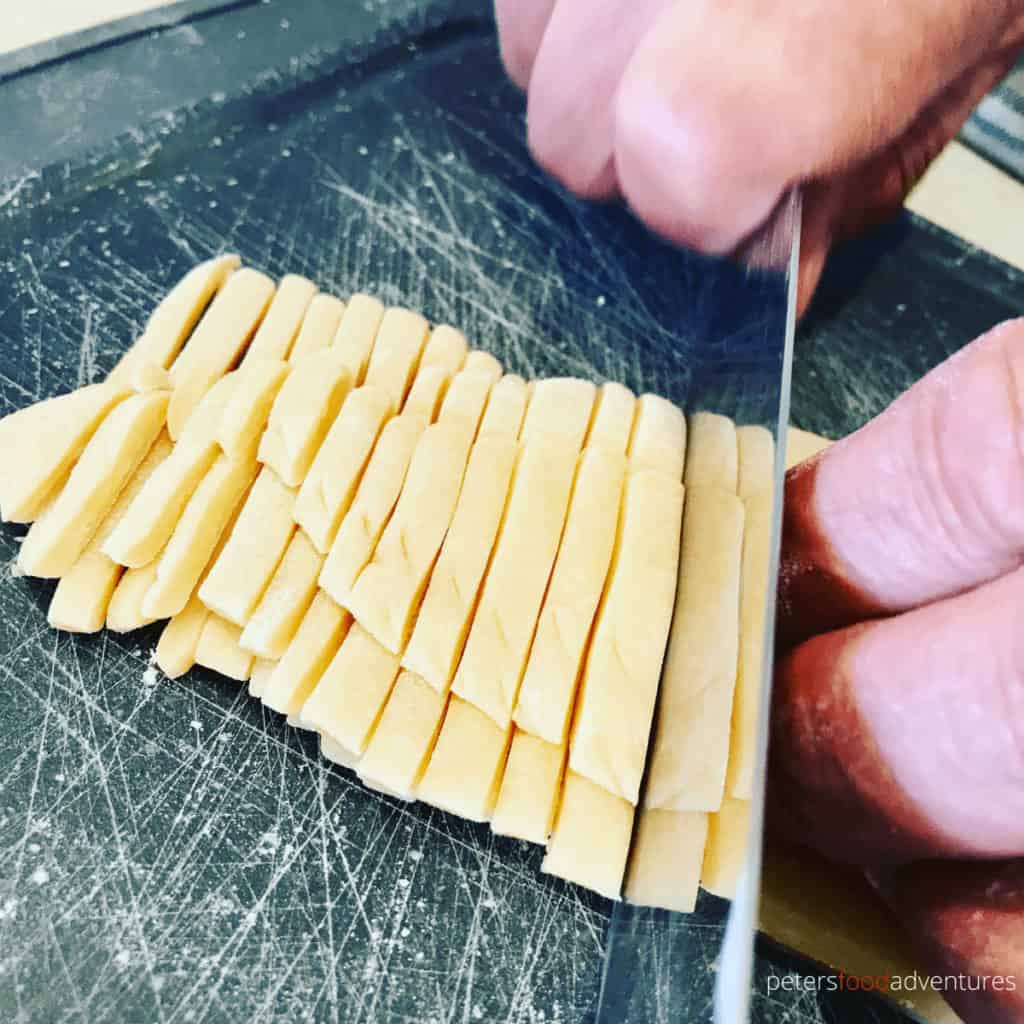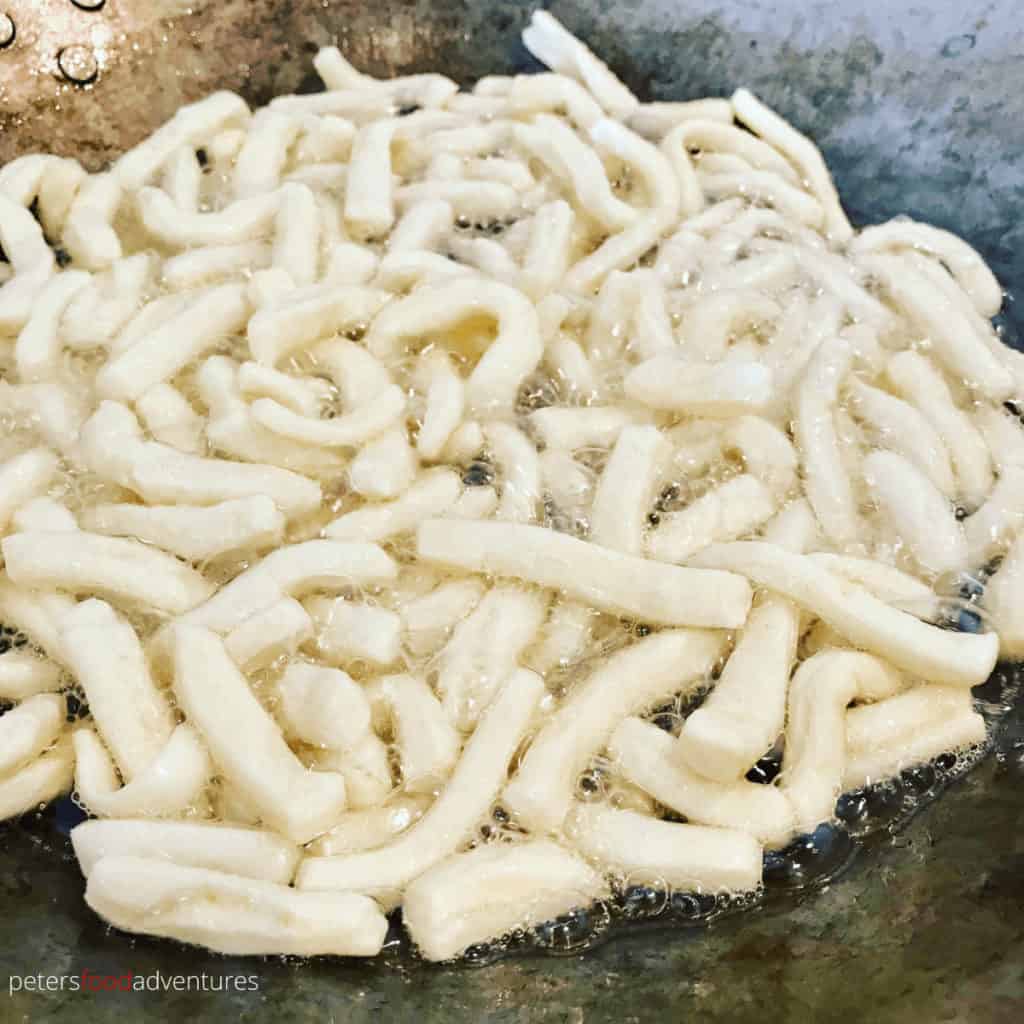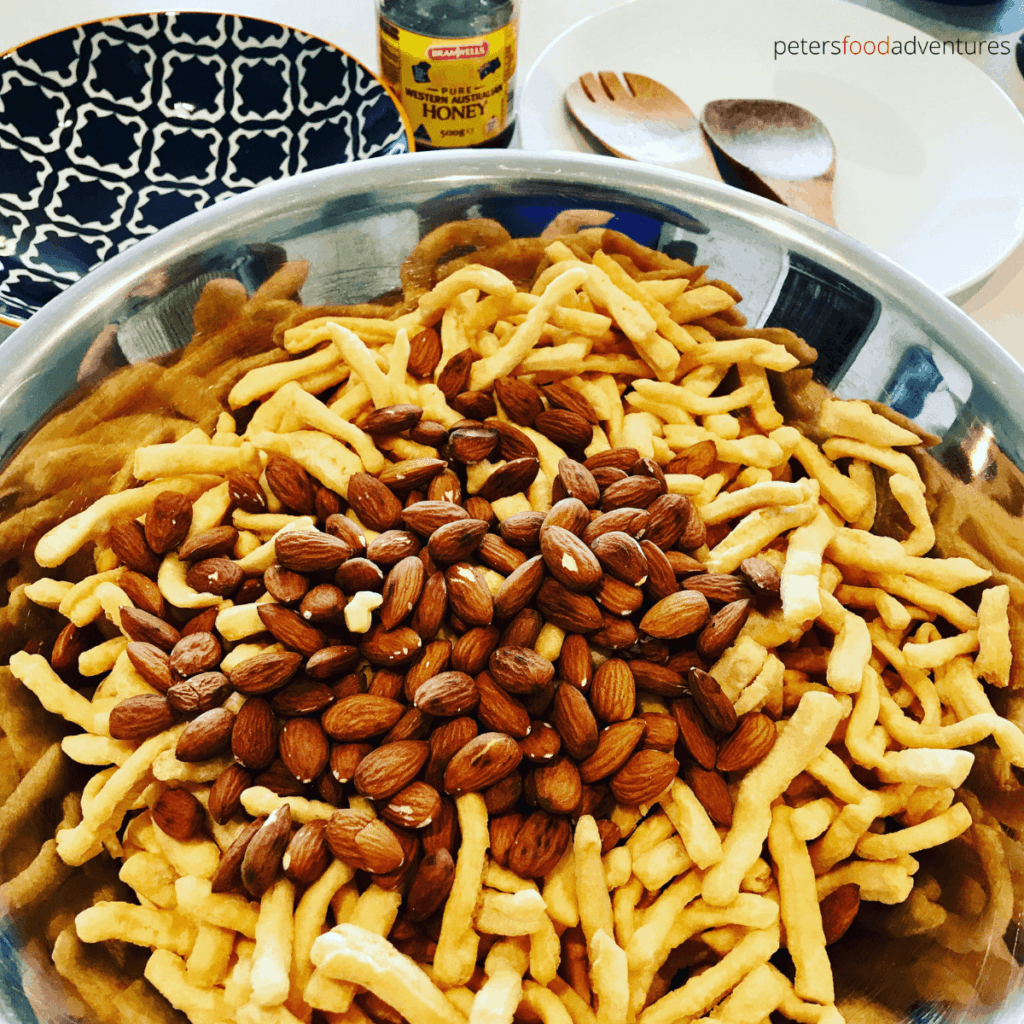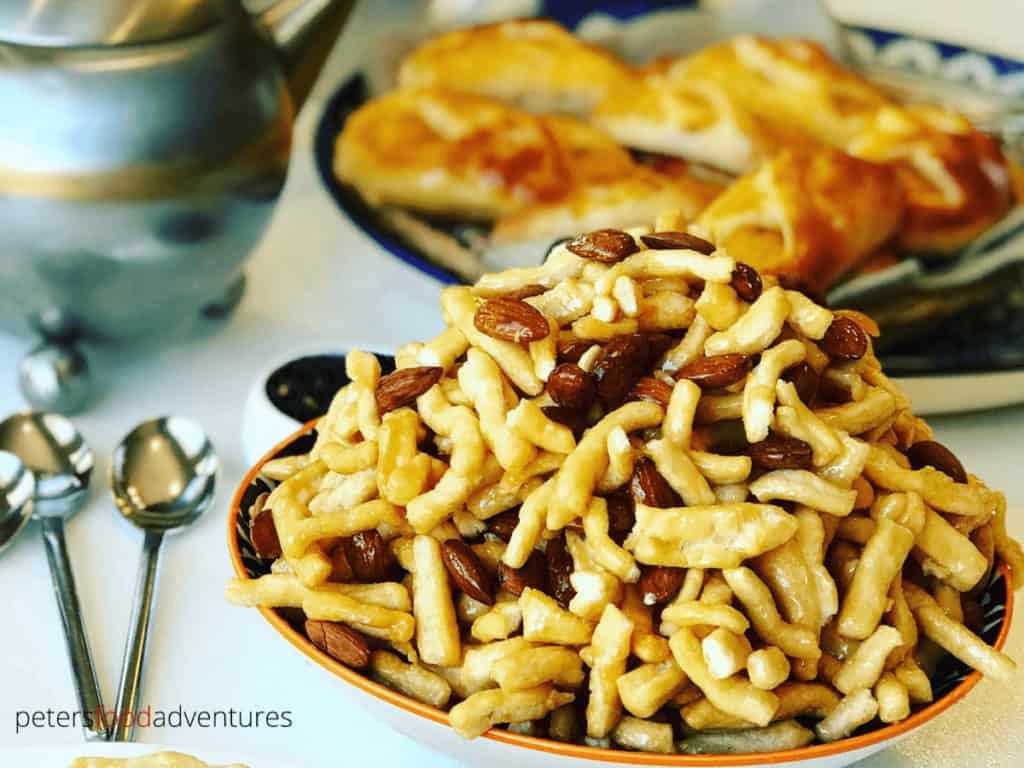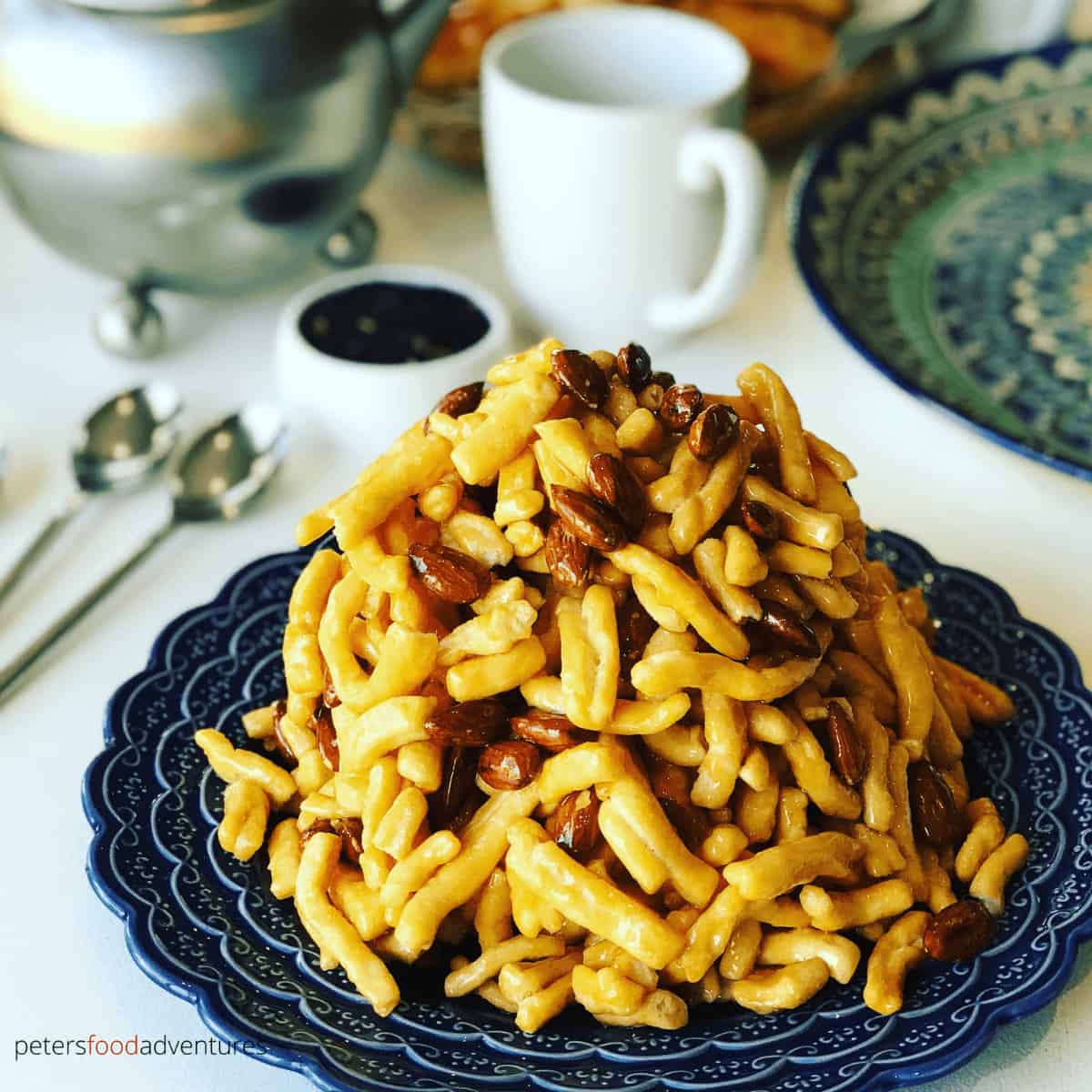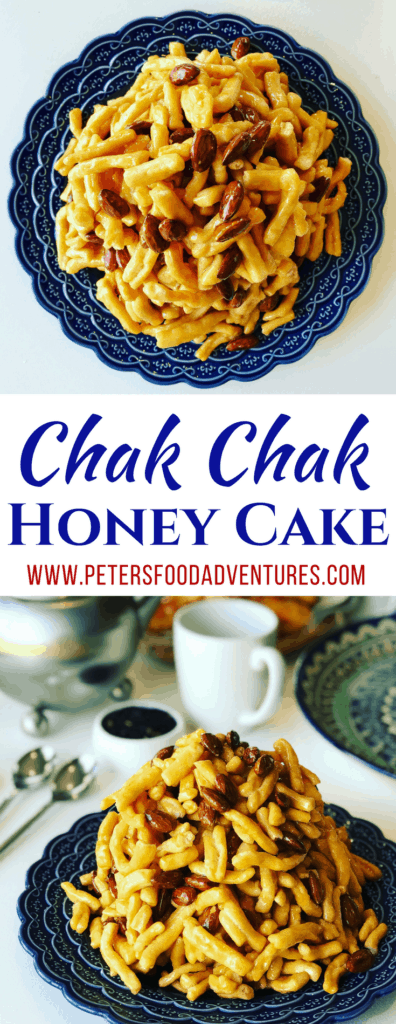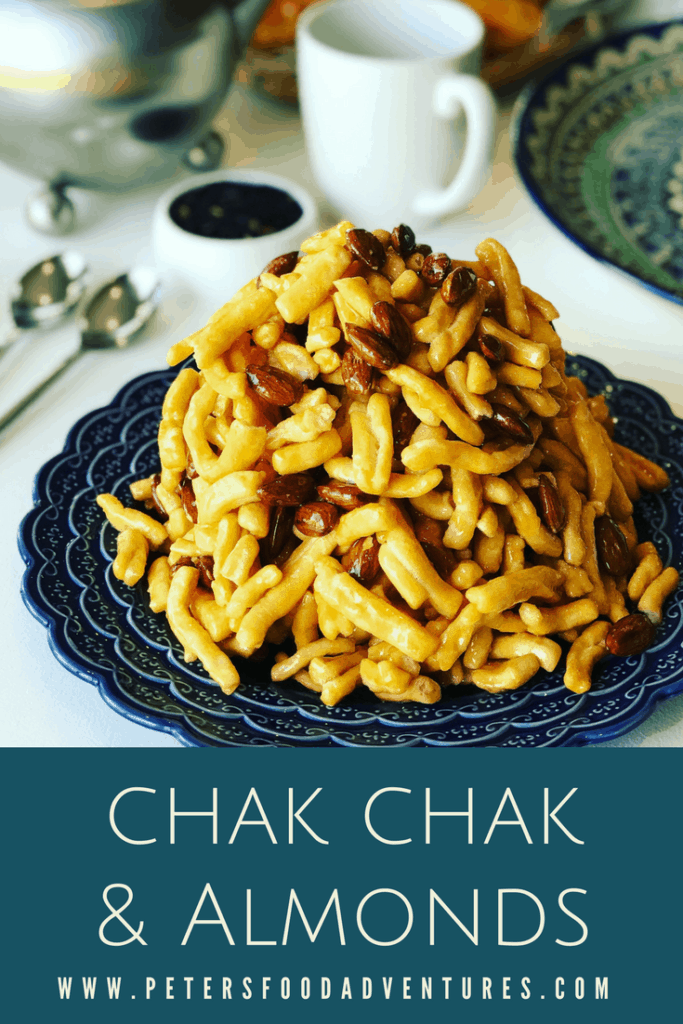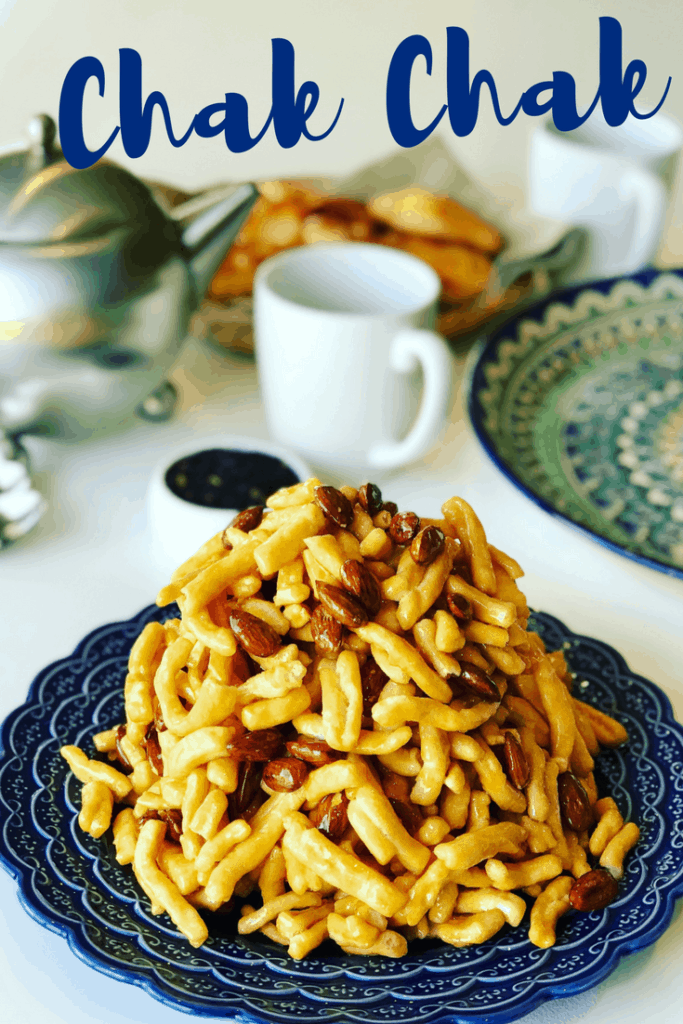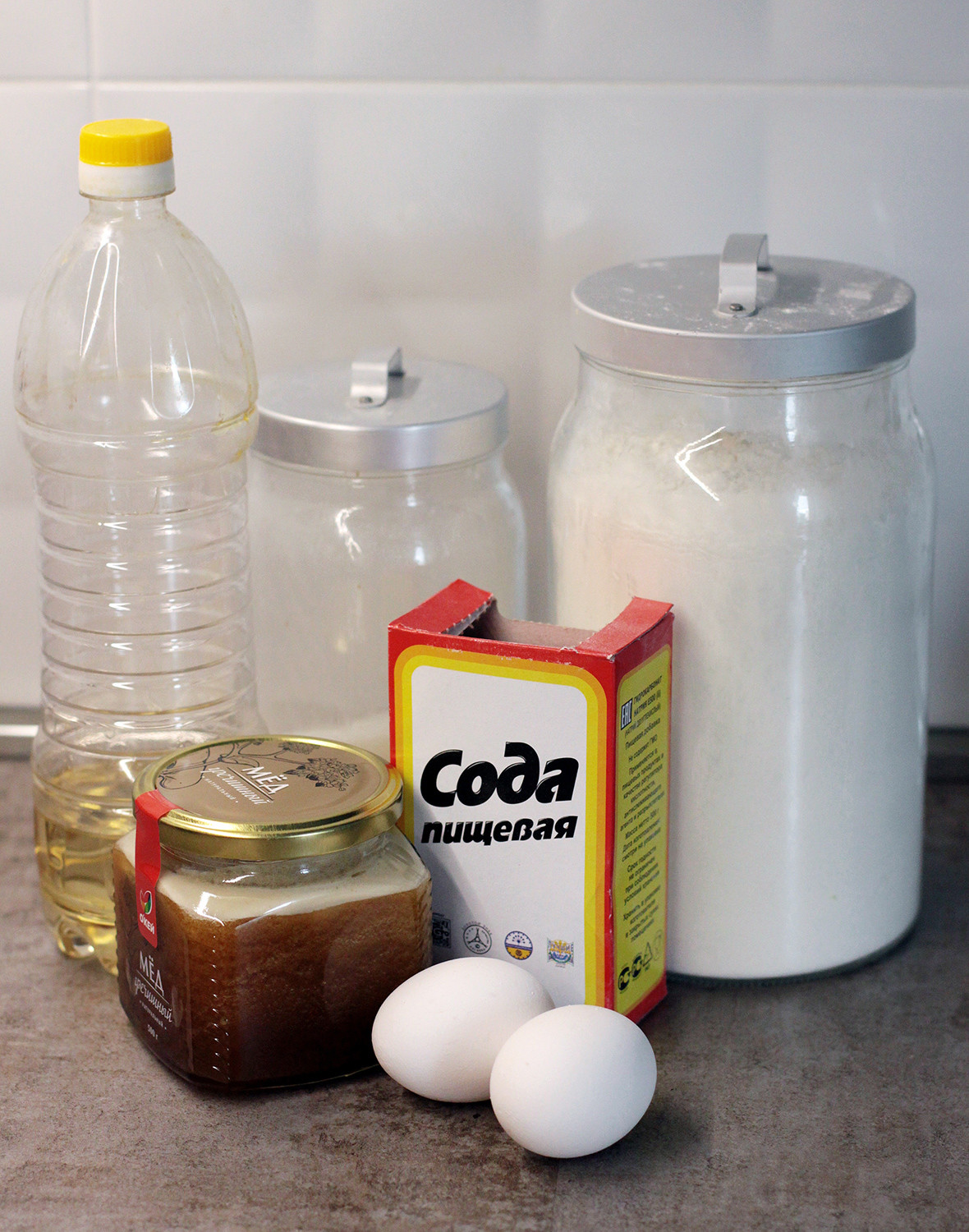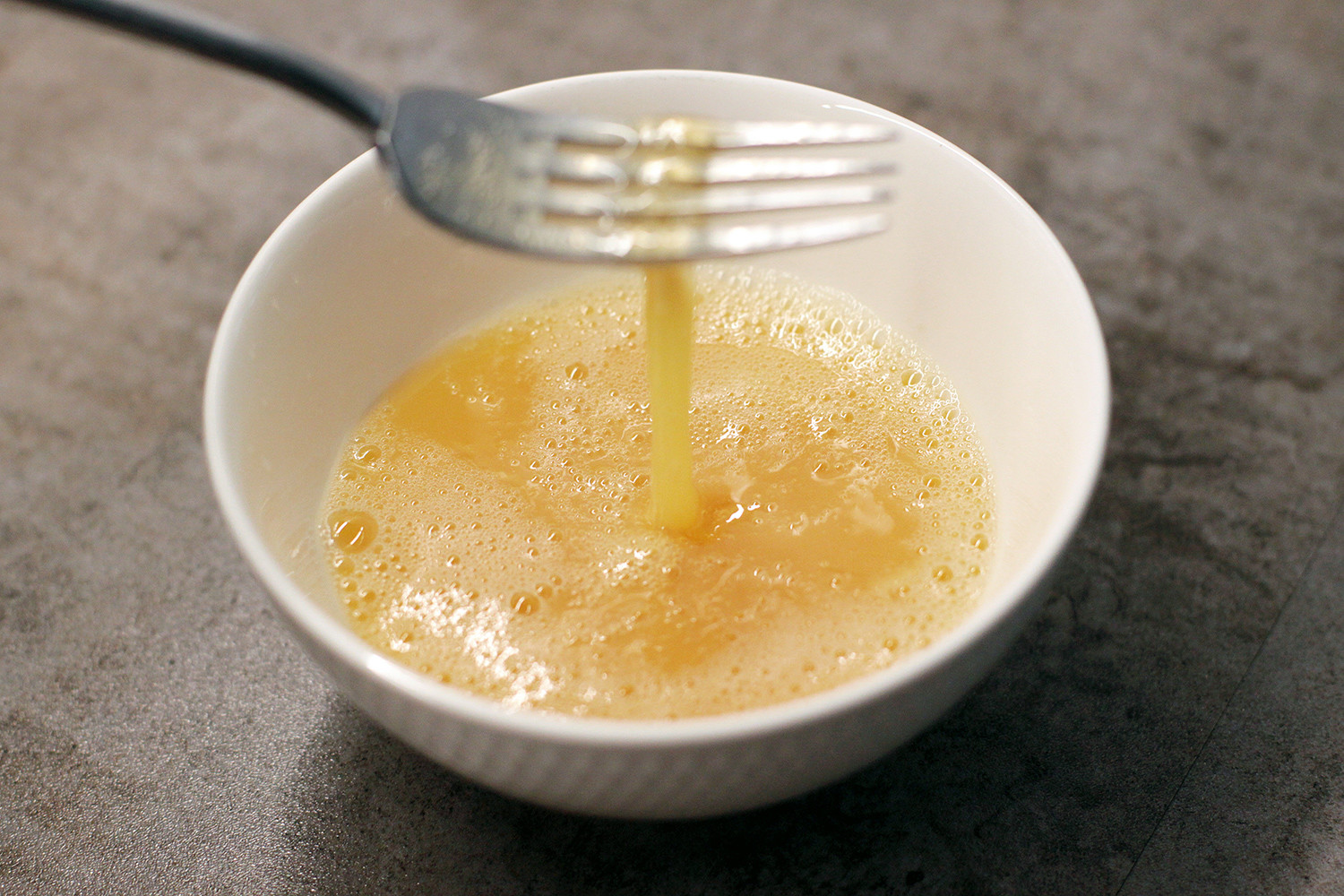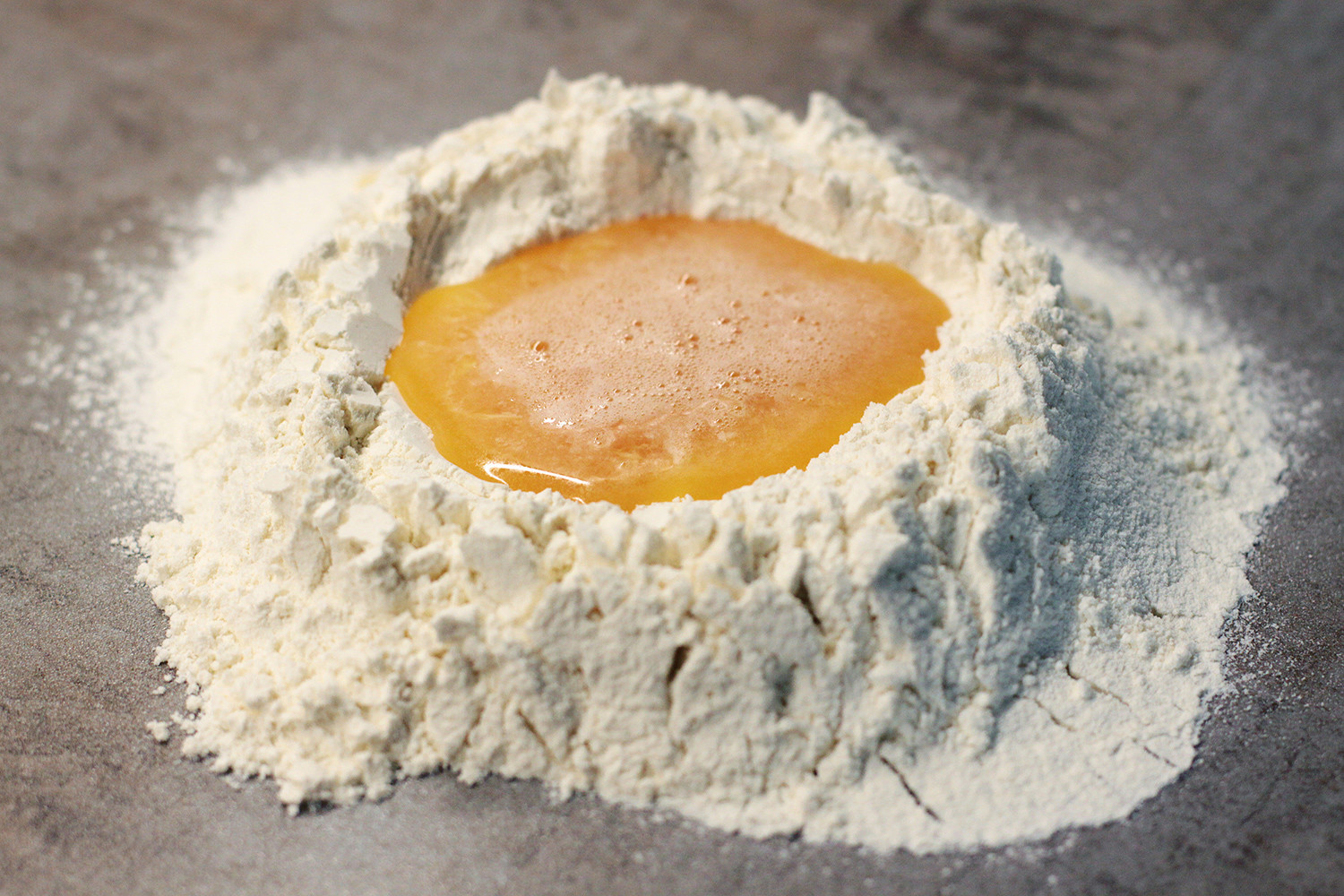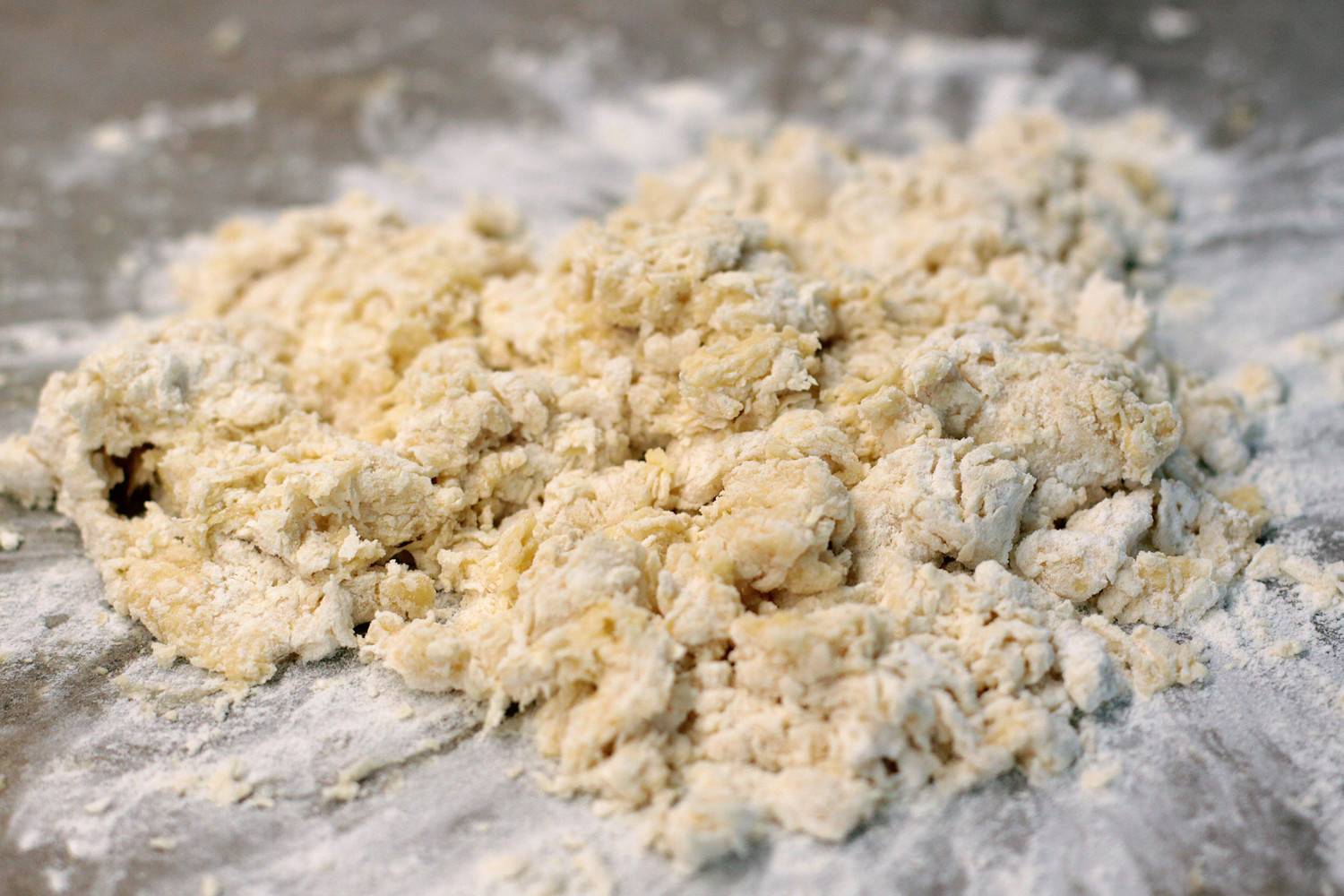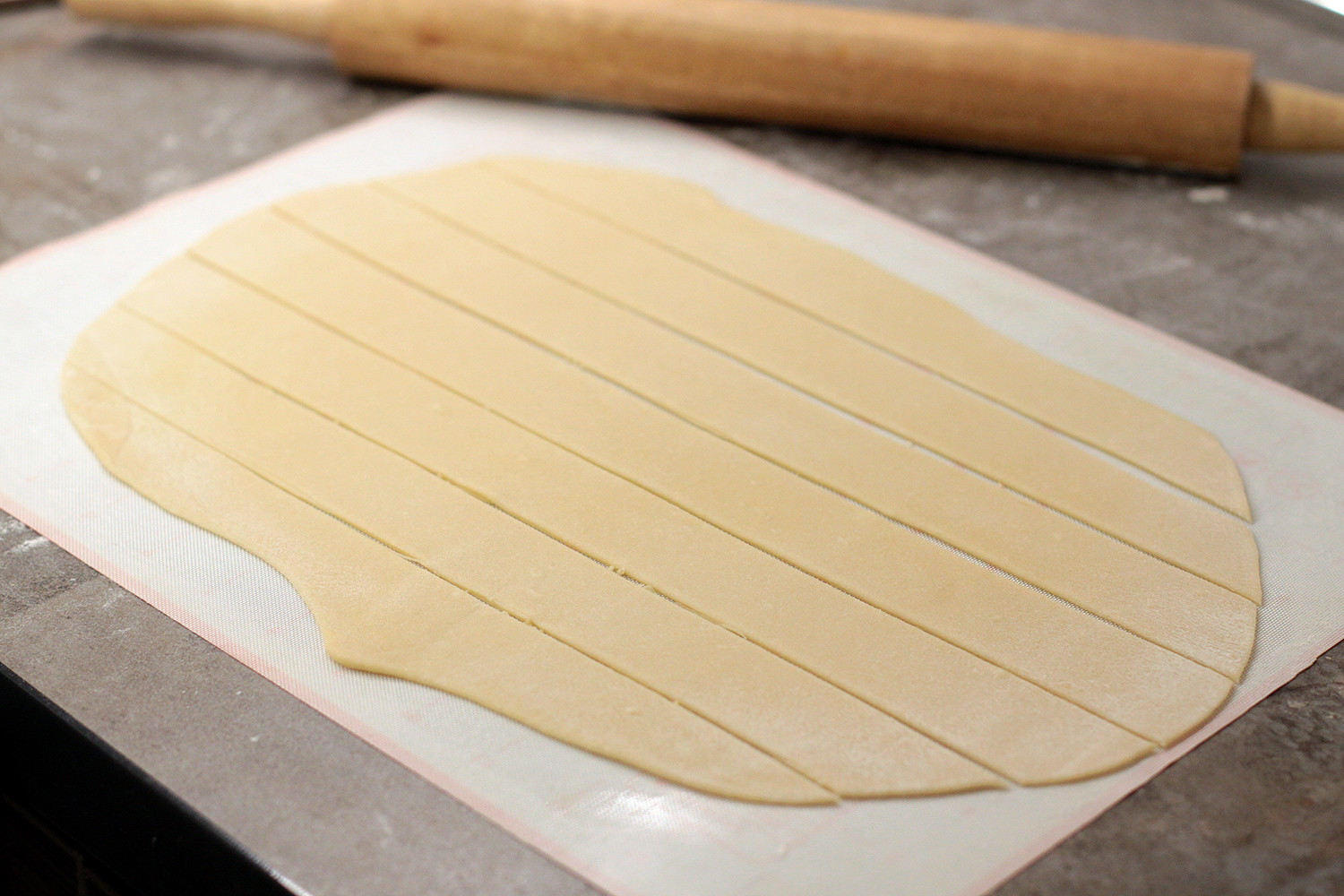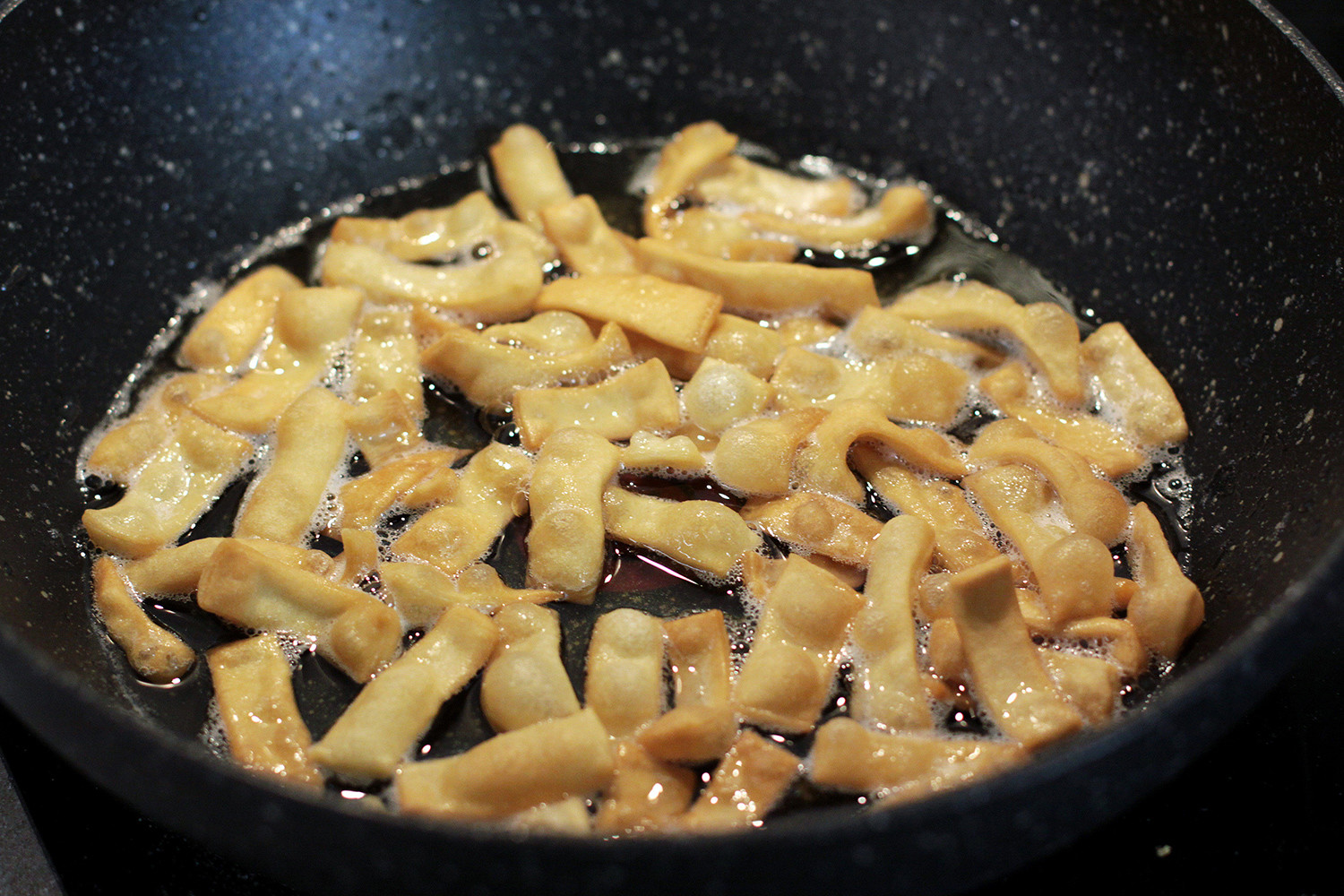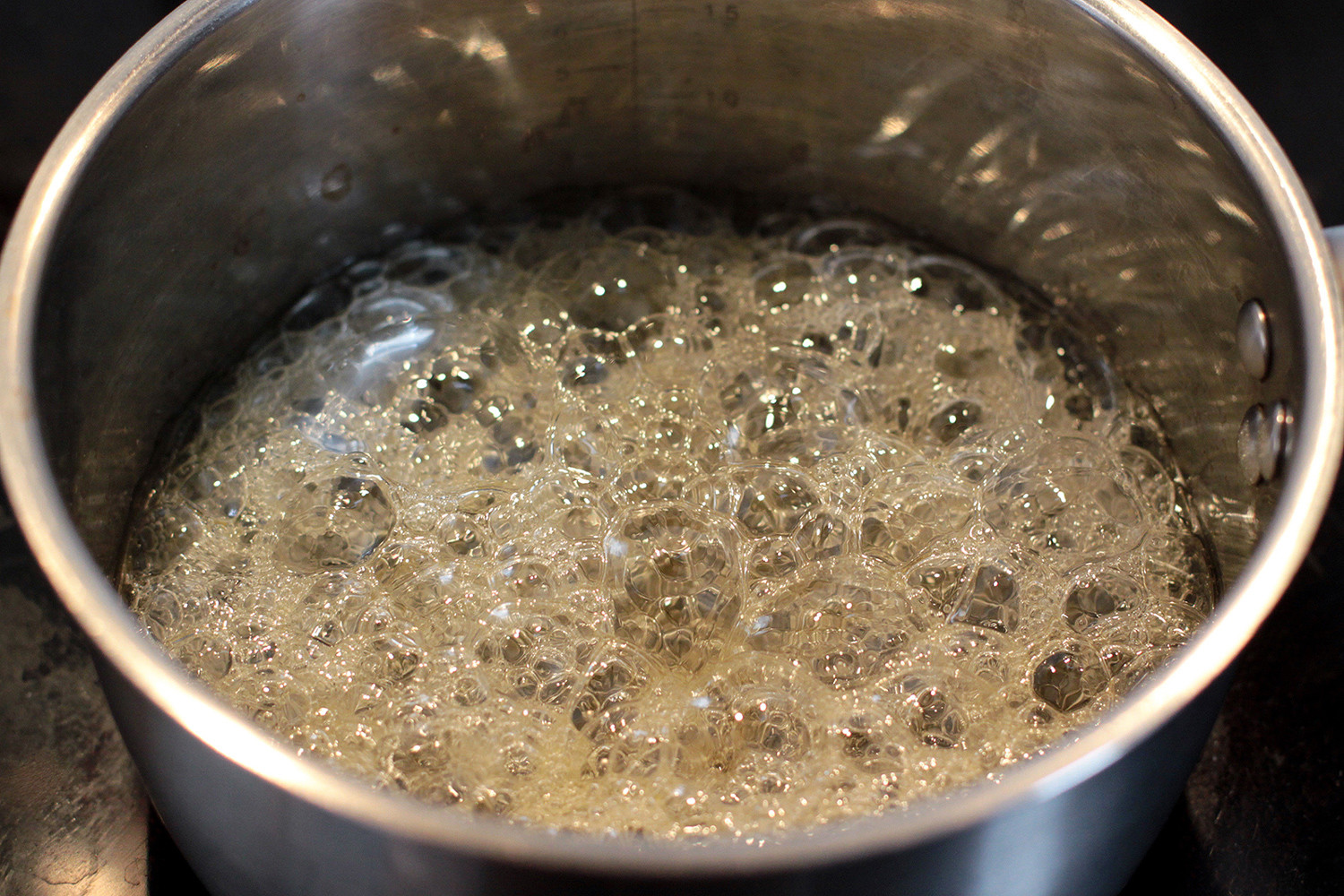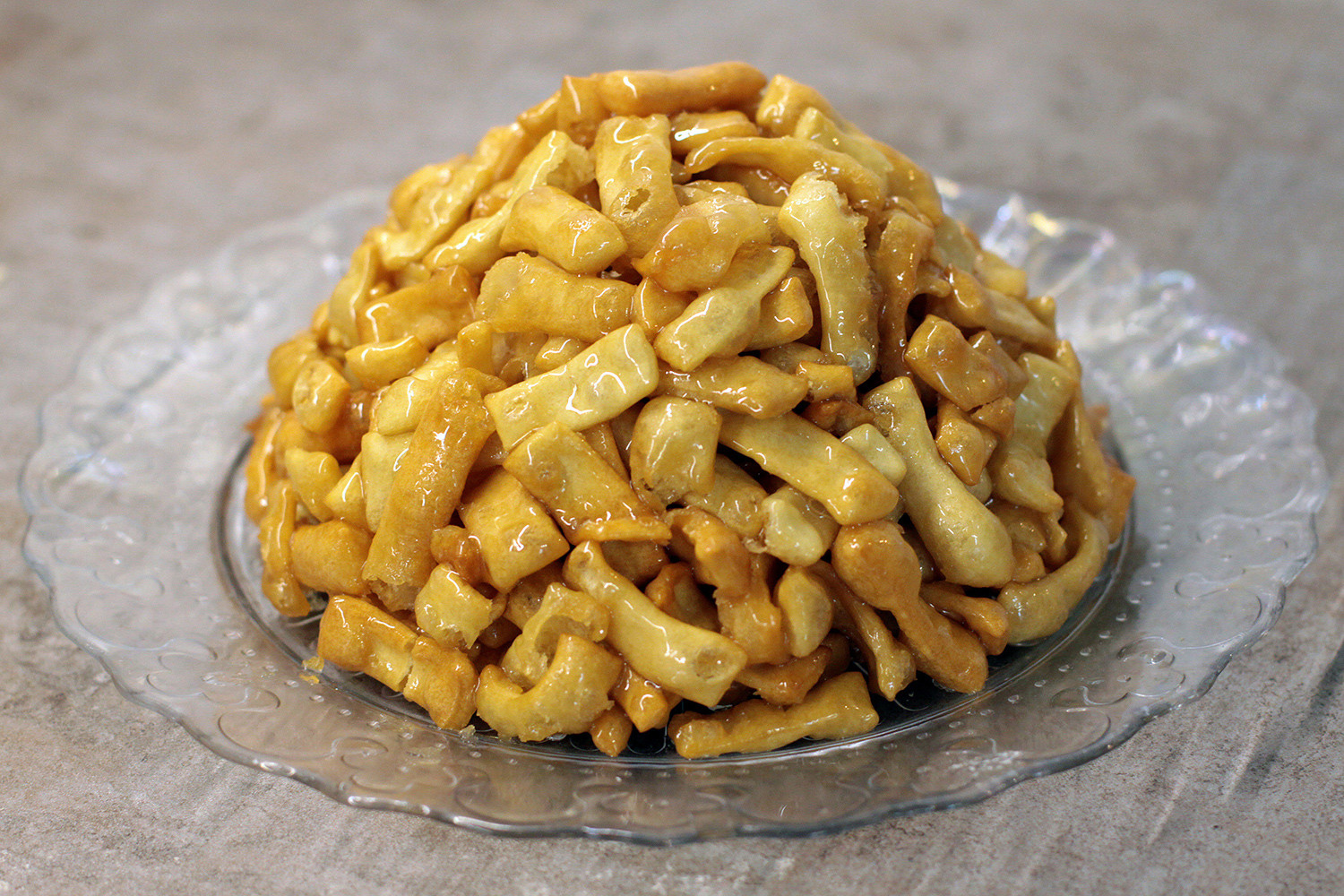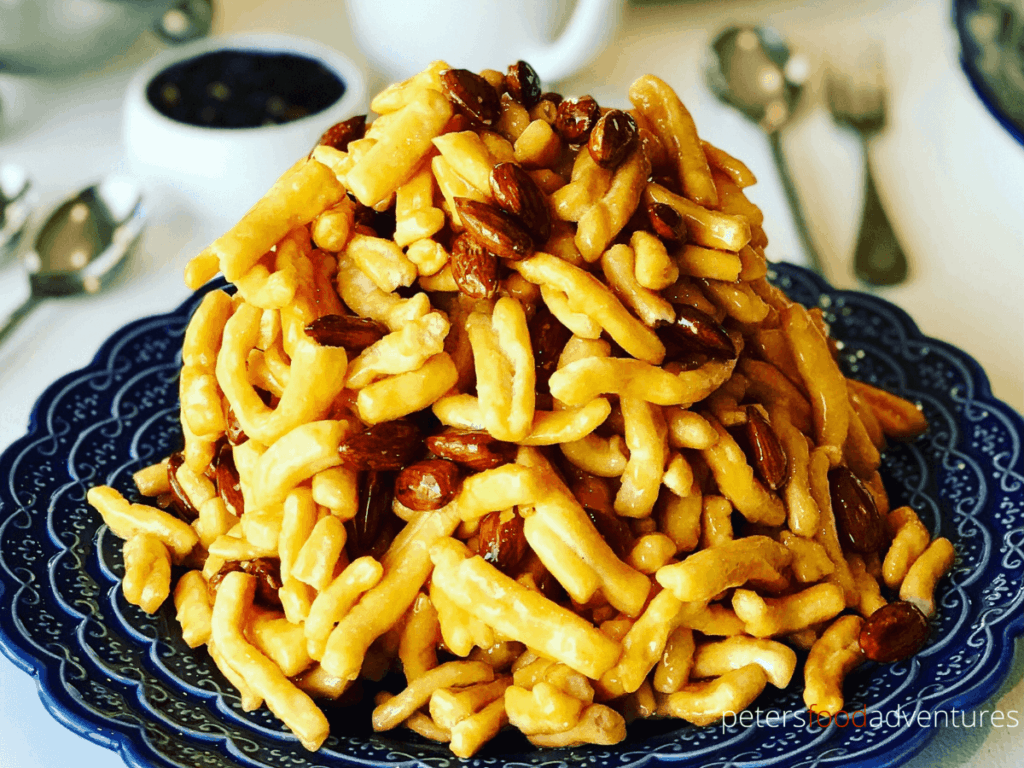
What is Chak Chak (Çäkçäk)?
Chak Chak (Чак-чак) — Fried Honey Cake with Almonds is a sticky and sweet dessert that’s absolutely delicious. During the time of the Soviet Union, the national dishes of the many cultures (including Tatar food) formed the foods of the Soviet people. This is different from Russian food. People often confuse Soviet food as Russian food. Soviet food forms the food from the cultures of Greater Russia and across Central Asia. Similar to European Food vs German food.
There are many wonderful dishes that were introduced across the Soviet States, and that have become staples across the republics. I bet most people have never heard of Tatarstan, or their dessert cake which is considered to be their national dish. Tatarstan is a republic located within Russia, about 800 km east of Moscow.
We grew up eating Чак-чак or Çäkçäk, but we called it something simpler — Gorka — which literally means little mountain. Chak-Chak is commonly piled high in the shape of a pyramid or a little mountain, or sometimes in small round balls, or in squares when it is mass produced and store-bought.
Is there alcohol in Chak-Chak?
Yes! It’s up to you to decide what to use. You can use either cognac or vodka for this recipe. If you don’t have cognac, brandy is the same thing. If you want to get fancy, use Armenian Cognac! Using alcohol in the recipe helps the fried dough pieces to be crispy.
How to Make Chak Chak
Prepare the sweet chak chak dough. Roll it out about ¼» thick and slice it into strips. Some recipes cut the dough pieces into small round pieces, the size of a pine nut. That’s time consuming and we always make them in small strips. Shake to separate the dough strips, and fry them in small batches in oil. Allow to cool on a paper towel.
Prepare the honey mix by boiling honey and sugar in a small pot. Toast the almonds in a frying pan. Place the Chak Chak and almonds in a bowl. Drizzle over with hot honey mixture and mix with 2 wooden spoons. As it sets very quickly, place it on a plate, press firmly and form a small mound. Use water on your hands for it to be less sticky. Allow to cool before serving.
I like this sweet dessert to be soft and sticky, so I use more honey. If you want it to set hard in the fridge, then use 50:50 mix of sugar and honey, or increase the sugar to 75% of the sugary sweetness. More sugar = harder Chak Chak.
When to Serve Chak Chak
Obviously, it’s a dessert! Traditionally it’s is eaten at special events ie. when a traveller arrives, or at a wedding or celebrations, however who wants to wait for those events to eat a delicious dessert? The rich honey cake isn’t hard to make, and has no fancy ingredients that you don’t have in your pantry. Basically it’s fried dough, covered with honey, sometimes with dried fruit and nuts. Hazelnuts or walnuts are commonly used but I love Chak Chak with toasted almonds. If served warm, it tastes amazing and it gooey, especially if using less sugar and more honey.
Usually you wait for it to set hard before serving. However, you should try it warm, especially with the toasted almonds! It’s quite a sweet recipe, I always enjoy it with Russian Zavarka Tea to wash it down with!
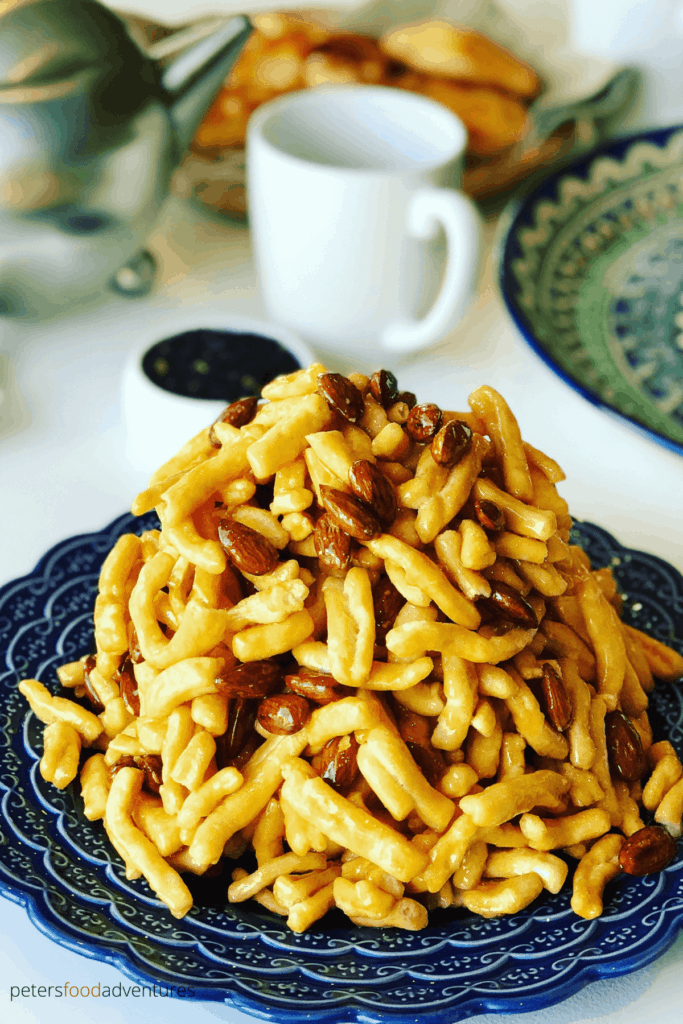
Now you have this recipe for Chak Chak (Чак-чак) and you need to try this wonderful dessert. Bon Appetit! Приятного аппетита!
A delicious Chak Chak recipe from Tatarstan. A Fried Honey Cake popular in Russia, Uzbekistan, Kazakstan and across Central Asia and the former Soviet Union. Chak Chak (Чак-чак) or Çäkçäk is served for guests, at weddings and celebrations.
Total Time: 1 hour 30 minutes
Course: Dessert, Sweets
Cuisine: Kazakhstan, Russian, Soviet, Tatar, Uzbek
Keyword: chak chak
- 2 cups flour
- 3 large eggs
- 1½ tablespoons cognac or vodka
- 200 grams toasted almonds optional
- 3 cups of oil
- 1 cup of honey
- ⅓ cup sugar
-
Using a whisk or a beater, beat the eggs together.
-
Add the cognac or vodka and stir until mixed.
-
Put the flour into a bowl and add the egg mixture and stir together breaking up any lumps and make a soft dough. Knead the dough on a floured surface and allow to rest for 15 minutes.
-
Roll out the dough into a thin layer, about ½cm or ¼» thick.
-
Cut the dough into thin long strips, about 1-2″ wide. You will now have lots of long strips of dough. Layer 3-4 strips on top of each other to make cutting easier, just sprinkle enough flour so they don’t stick. Cut these long strips into small pieces about ½ cm or ¼» wide. Shake them to separate immediately. Remember that their size will double or triple when you fry them in oil.
-
Heat the oil on high until hot. Test by putting one piece of dough in the pot, and it should crackle and start to expand.
-
Fry the dough pieces in small batches in the hot oil until golden yellow and set aside on a paper towel to drain the oil. (Don’t overcook them so they are brown — keep lightly golden)
-
Put the honey and sugar into a saucepan and cook on low for about 5 minutes and heated and sugar is dissolved into the honey. You can also use a double boiler to melt the sugar and honey together.
-
In a frying pan, toast almonds on medium heat until they are golden brown and toasty.
-
Prepare the plate that your Chak Chak will be presented on. Put the fried pieces of dough and toasted almonds into a large bowl and pour the hot honey mixture over and mix together using 2 wooden poons until it’s all combined. You must work very fast, as the honey will set very quickly.
-
Final step, place the Chak Chak on the plate and form a hill or a pyramid with your hands. Again, this must be done very quickly as it sets fast. It’s helpful to wet you hands with cold water to help you form the pyramid.
-
Refrigerate before serving to allow the Chak Chak to cool and set, or serve immediately warm in smaller portions.
Mention @petersfoodadventures or tag #petersfoodadventures!
©PetersFoodAdventures.com
Have you ever cooked a fried cake? Try this deep fried honey dessert and you will want to make it over and over again.
Lots of pieces of crunchy dough generously soaked in sweet honey syrup – that’s traditional Tatar chak-chak. In Tatar language, “chak-chak” means “a little bit” or “small”: perhaps it’s all about small pieces of dough from which the dessert is made. But some believe that the name resembles the sound of a knife cutting a piece of crispy dough. Well, no one knows for sure where the name comes from.
It is widely considered that the recipe came from the Volga Bulgaria region, which is now part of European Russia. A legend says that the great Khan of the region asked his chefs to make a new dessert for his son’s wedding. The sweet dish had to be able to be stored for a long time, as well as nutritious and easy to make, but at the same time it had to be impressive looking. The Khan sampled numerous desserts but his choice fell on this simple sweet dish.
Initially, chak-chak was a kind of ritual dessert that was cooked for major celebrations and weddings – it was served on festive tables as a symbol of good marriage, love and strong family life. Today, you can find it in many grocery stores all over Russia.
Chak-chak is easy to make at home, and the best part is that you only need the simplest ingredients. Another great thing is that it can be stored for weeks. But I promise, you won’t need that much time: in my family’s experience we usually devour it very quickly.
Ingredients for the dough:
- 200g flour;
- 2 large eggs;
- 1 tsp. sugar;
- ½ tsp. baking soda;
- a pinch of salt;
- oil for frying.
Ingredients for the syrup:
- 250g honey;
- 50g sugar.
Cooking:
1. Using a hand whisk or a fork, beat the eggs and mix the sugar, salt and baking soda in a bowl until smooth.
2. Sift the flour on a clean cooking surface and create a kind of hollow in the middle; use around 180g of flour and then use the rest for the cooking surface later on. Carefully pour the beaten eggs into the hollow and, using a fork, start mixing it with the flour.
3. When the dough gets thicker, continue kneading it with your hands for around 5 minutes, until it gets soft and does not stick to your hands.
4. Round the dough into a ball, put in a plastic bag or container, and allow to rest in a cool corner for 20 minutes.
5. Divide the dough into two equal pieces and start rolling one at a time. Roll one piece into a thin rectangle layer about 2-4mm thick; then cut the layer into strips that are about 4cm wide, and leave for 10 minutes to dry.
6. Dust the strips with flour, and layer on top of each other. Cut them crosswise into narrow pieces about 5mm wide: they should separate very easily. Repeat the process with the second dough ball to get many small dough “noodles”.
7. When you are finished with cutting all the dough, pour enough oil into a deep pot: you will need at least 300ml for frying. Bring it to medium-high heat and test by putting one “noodle” into a pot: if it starts expanding immediately, then the temperature is right. Start frying the “noodles” in small portions – one handle at a time will be enough, the dough expands in size while cooking.
8. Constantly stir the dough pieces with a skimmer while frying, and cook until golden – it usually takes one or two minutes. Place the ready “noodles” on paper towels to absorb extra oil and continue frying.
9. To make syrup, just mix sugar with honey in a pot and bring to a boil on low heat.
10. Simmer the syrup for a minute or two and quickly remove from heat.
11. Transfer all the fried dough pieces in a large bowl, and pour the hot syrup over and immediately start mixing chak-chak with a wooden spoon to cover the “noodles” with honey.
12. Then gently transfer the mixture on a prepared dish, dip your hands in cold water and shape chak-chak in a pyramid – make it quickly because chak-chak sets fast. You may decorate the cake with your favorite nuts.
13. Some say chak-chak needs to sit for several days before eating, but it’s impossible to resist for so long. So, leave the dessert at room temperature for several hours, or put in the fridge if you prefer serving it cold. Enjoy with black tea!
Read more: 6 dishes that’ll make you want to learn Tatar and visit Kazan
If using any of Russia Beyond’s content, partly or in full, always provide an active hyperlink to the original material.
Get the week’s best stories straight to your inbox
«Chekchek» redirects here. For places in Iran, see Chekchek, Iran.
Çäkçäk (pronounced [ɕækˈɕæk], Yañalif: Cəkcək, Tatar Cyrillic: Чәкчәк[1] or чәк-чәк, çäk-çäk; Tajik: чақчақ, chaqchaq; Kyrgyz: чак-чак; Uzbek: chak-chak; Russian: чак-чак, chak-chak; Bashkir: сәк-сәк, säk-säk, Kazakh «чак-чак», frequently anglicized as chak-chak (), is a Tatar sweet. It is particularly popular in Tatarstan and Bashkortostan, and is recognized as Tatarstan’s national sweet in Russian Federation.

Çäkçäk (right) and Boxara käläwäse (left) |
|
| Type | Doughnut |
|---|---|
| Place of origin | Russia |
| Region or state | Tatarstan and Bashkortostan |
| Main ingredients | Dough, optionally hazelnuts |
|
Çäkçäk is made from unleavened dough cut and rolled into hazelnut-sized balls, which are then deep-fried in oil. Optionally hazelnuts or dried fruit (e.g.apricot and raisin) are added to the mixture. The fried balls are stacked in a mound in a special mold and drenched with hot honey. After cooling and hardening, çäkçäk may be optionally decorated with hazelnuts and dried fruits.
Traditional wedding çäkçäk is of bigger size and is often covered with candies and dragées. The biggest çäkçäk (4026,4 kg) was prepared on 14 June 2018 during the opening of FIFA fans in Kazan.[2]
TypesEdit
- If the dough is fried as noodles, çäkçäk is called Boxara käläwäse (Бохара кәләвәсе, [bɔxɑˈrɑ kælæwæˈse], i.e. Bukharan käläwä ).[1]
- Kazakh shek-shek is similar to Boxara käläwäse.
- Uzbek chakchak comes in half rounded balls, noodles and flakes types.
- Tajik chakchak comes in both types, as balls and as noodles.
See alsoEdit
- List of doughnut varieties
- List of fried dough varieties
- List of Russian dishes
- Tatar culture
- Tatar cuisine
- Lokma (a similar dish originating in Turkey)
- Struffoli
- Sachima (a similar dish in Manchu cuisine)
- Gavvalu (a similar dish in India)
- Funnel cake
ReferencesEdit
- ^ a b «Чәкчәк». Tatar Encyclopaedia (in Tatar). Kazan: The Republic of Tatarstan Academy of Sciences. Institution of the Tatar Encyclopaedia. 2002.
- ^ «Самый большой чак-чак в мире». www.pari.ru.
External linksEdit
Wikimedia Commons has media related to Çäkçäk.
- My Home — Tatar cuisine recipes
- 22
Дек 17
Unit 4. What do you celebrate?
Reading lesson. Chuck and his pets
Упражнение 5, с. 40 — 41
5. Чаку Смиту родители подарили кошку и котёнка.
1) Был ли Чак рад такому подарку?
Chuck Smith was a little boy. He lived with his mother and father in a beautiful house in Ulster. There was a big garden around their house. His dad and mum gave a gift to him. It was a cat and a kitten. The cat and the kitten had beautiful names. The cat was Duchess. The kitten was her baby. His name was Sunny. They lived in this house, too.
Chuck was a good boy. Everybody loved him. But Duchess the cat and Sunny the kitten didn’t like Chuck at all.
Chuck loved Duchess and Sunny very much. He loved them more than his toys. But Duchess and Sunny ran away when they saw him. Why did they run away?
Chuck always took the cat and the kitten in his arms. He hugged them and kissed them all the time. And they didn’t like to be in his arms. Duchess and Sunny always ran away.
Чак Смит был маленьким мальчиком. Он жил со своей матерью и отцом в красивом доме в Ольстере. Вокруг их дома был большой сад. Его папа и мама подарили ему подарок. Это была кошка и котёнок. У кошки и котёнка были красивые клички. Кошку звали Герцогиней. Котёнок был её ребёнком. Его звали Солнышко. Они тоже жили в этом доме.
Чак был хорошим мальчиком. Все его любили. Но Герцогиня — кошка и Солнышко — котёнок совсем не любили Чака.
Чак очень любил Герцогиню и Солнышко. Он любил их больше, чем свои игрушки. Но Герцогиня и Солнышко убегали, когда видели его. Почему они убегали?
Чак всегда брал кошку и котёнка на руки. Он обнимал их и целовал всё время. И им не нравилось, когда их брал он на руки. Герцогиня и Солнышко всегда убегали.
Ответ: He (Chuck) loved them (Sunny and Duchess) more than his toys.
2) Reading rules. Как правильно произнести имя мальчика и имена домашних питомцев? Допишите транскрипцию.
Chuck [tʃʌk]
Duchess [’dʌtʃɪs]
Sunny [’sʌnɪ]
3) Reading rules. Какие ещё слова произносятся по таким же правилам чтения? Найдите 6 слов.
Ulster, mum, but, much, run, hug.
4) Выберите те значения слов, которые помогут понять эту историю.
arm — рука,
hug — крепко обнимать, сжимать в объятьях,
kiss — целовать
5) Поставьте галочку (V) после вопросов, на которые есть ответы в тексте, и ответьте на эти вопросы.
a) Where did Chuck and his parents live? V
b) Did they have pets? V
c) What pets did they have? V
d) What games did Chuck and the cat play?
e) Did Chuck love the cat and the kitten? V
f) What did the cat and the kitten run away? V
g) Did the the cat and the kitten love Chuck? V
6) Почему кошка и котёнок убегали от Чака? Выпишите предложения.
Chuck always took the cat and the kitten in his arms.
He hugged them and kissed them all the time.
And they didn’t like to be in his arms.
ГДЗ по английскому языку. 3 класс. Reader. Книга для чтения. Кузовлёв В.П., Лапа Н.М., Костина И.П., Кузнецова Е.В.
Английский язык. 3 класс
3 класс. Reader. Упражнение 5, с. 40 – 41
4.2 (84.44%) от 36 голосующих
Сочинение
Чак-чак – оригинальное блюдо татарской национальной кухни
Работу выполнил: Гилязов Рамиль Рустемович, 7 класс
Руководитель: Гилязова Гульчачак Аглямовна
учитель истории и обществознания
Муниципальное бюджетное общеобразовательное учреждение
«Биюрганская основная общеобразовательная школа»
д. Биюрган
2015 год
На столе чак-чак стоит,
Лучшим мёдом он облит.
Слаще блюда не найти,
Хоть пол-мира обойди.
Наш чак-чак, друзья, полезен,
Всему миру он известен.
Им гордится наш народ,
Так и просится сам в рот!
Кулинарное искусство татарского народа богато своими национальными традициями, уходящими в глубь веков. В процессе многовековой истории сложилась оригинальная национальная кухня, сохранившая свои самобытные черты до наших дней.
С ростом благосостояния народа и повышения его культурного уровня появилось много новых блюд и изделий, таким образом обогатилась национальная кухня.
Искусные повара и кулинары и сегодня придумывают новые блюда, оригинальные рецепты. Но несмотря на это, на праздничном столе у нас всегда чак-чак. Чак-чак национальное татарское лакомство, символ гостеприимства. Действительно, не одно блюдо не сравнится своим вкусом с чак-чак. Само название говорит, что надо есть его по чуть-чуть. Даже в наши дни не все повара умеют готовить чак-чак, хотя имеют высшие образование. А наши бабушки так вкусно его готовили, что можно было язык проглотить.
Искусство приготовления чак-чак пришло к нам из Булгарских времён.
Легенда гласит, что однажды хан Булгарии решил женить своего единственного сына и захотел чтобы на свадебном столе стояло новое угощение:
- Чтобы оно удивляло всех простотой приготовления, чтобы долго не портилось и при этом не теряло бы своих вкусовых качеств.
- Чтобы это блюдо было очень питательным, а воины могли бы его есть не слезая с седла.
- И главное условие – чтобы это блюдо могло бы украшать любое торжество как символ и олицетворение всего народа великой Булгарии.
- И не стыдно было бы его не только подавать на стол лучшим гостям, но и отправлять в качестве гостинца в дальние страны.
- И чтобы там за морями, попробовав это блюдо, каждый захотел бы взглянуть на великую Булгарию!
Долго старались мастера кулинарного искусства, повара и простые жители ханства. Много интересных и вкусных блюд перепробовал хан и из великого множества блюд он выбрал одно, идеально подходящее ко всем требованиям – Чак-чак приготовленный из муки, яиц и мёда женой одного пастуха. И на свадьбе единственного сына хан преподнес молодожёнам великолепный чак-чак. И при этом пожелал чтобы они жили прилипши друг к другу как мёдом помазанный этот чак-чак, чтобы детей у них было столько сколько горошин в этом чак-чаке, чтобы жили они в золоте и жизнь их шла только в гору, чтобы речи друг для друга у них всегда были только сладкими. Чтобы они держались со своей семьёй и со своим народом как этот в кучу собранный чак-чак. С тех пор на татарских свадьбах, как самое дорогое угощение и украшенье стола молодым преподносят чак-чак.
Стоит отметить, что раньше чак-чак не был повседневным угощением. Его готовили только к большим праздникам, дарили во время свадеб. Родители молодых, навещая друг друга, приносили в качестве гостинца пироги и непременно чак-чак. Готовили его особенно: все девушки на выданье катают тесто, другие его режут, замужние девушки его жарят, а самое старшее поколение занимается медовой заливкой и формированием праздничного готового блюда. Сейчас это блюдо стало практически повседневным.
Фото автора
В нашей деревне многие хозяйки сами стали готовить чак-чак. Они чак-чак готовят для своих семейных праздников и на заказ. 18 декабря в нашей деревне прошел праздник под названием «Чак-чак – украшение праздничного стола». На этом празднике можно было увидеть много разновидностей чак-чака. Их приготовили женщины – жители нашей деревни. А Гульсария ханум показала мастер – класс по приготовлению этого национального блюда.
Фото автора
Участники праздника могли наблюдать этапы приготовления чак-чака, так же дегустировать полученное блюдо.
Казалось бы ничего сложного, но только хороший мастер знает от скольких тонких и важных мелочей зависит успех. Чак-чак готовиться практически вручную, имеет много своих секретов как при подборе ингредиентов, так и в остальных технологических процессах. Поэтому научиться приготовить чак –чак, мне кажется, не очень то легко. С первого раза может и не получиться, нужно много практики и опыта.
Фото автора
Чак-чак настоящее лакомство для детей и взрослых. Внесет особый душевный настрой дружеской беседе за чашечкой ароматного чая с гостями и родственниками. Имеет оригинальный и изысканный вкус. Золотистая пирамида зерен из обжаренного пшеничного теста, благоухающая мёдом по душе даже самому утонченному гурману.
Использованная литература:
- Юнус Ахметзянов «Татарские национальные блюда» Казань, Татарское книжное издательство, 2013
- Марина и Михаил Медведевы «Татарская кухня», издательство «Стар»
- Всемирный конгресс татар http://tatar-congress.org/yanalyklar/tabyn-kyrke-chek-chek/
На основании Вашего запроса эти примеры могут содержать грубую лексику.
На основании Вашего запроса эти примеры могут содержать разговорную лексику.
Перевод «ЧАК-ЧАК» на английский
Предложения
Человек, который будет разрезать свадебный чак-чак, назначается родителями невесты.
The man who will cut the wedding chak-chak, appointed by the bride’s parents.
Объем темах в ходе визита намного превышают чак-чак, и регулярно менять.
The scope of topics covered during a visit far exceed chak-chak, and routinely change.
Сувенирный «ЧАК-ЧАК» можно будет приобрести на вокзалах и в аэропортах Башкирии, а также в некоторых гостиницах республики.
Chak-Chak gift will be available at railway stations and airports of Bashkiria, as well as some of the hotels of the country.
Главная/ В Перми создали официальный сайт о татарской молодёжной организации «ЧАК-ЧАК»
Next: In Perm, the official site of the Tatar youth organization «CHAK-CHAK» created
Ждали вечера, садились за стол и заваривали чай из степных трав» — гласит легенда ЧАК-ЧАК, которая была написана по следам тысячелетней кочевой истории кипчаков специально для сувенирного бренда.
The people waited for night to fall, when they would sit down at the table and boil tea made from steppe grass So goes the CHAK-CHAK legend, written in the wake of the thousand-year history of the Kipchak nomads, especially for a souvenir brand.
В музее Чак-Чак, абсолютно все можно забрать, коснулся и чувствовал.
In the Chak-Chak Museum, absolutely everything can be picked up, touched and felt.
Он тоже был сладкий, как чак-чак!
He too was sweet, just like chak-chak!
Кстати, название комплекса Чак-Чак произошло от звука падающих на пол капель.
By the way, the name of the Chak-Chak complex came from the sound of drops falling to the floor.
Ну и, конечно же, попробовать и купить чак-чак, приготовленный по странному рецепту.
And, of course, try and buy a chak-chak cooked according to a secret recipe.
Равшана принес тарелку, наполненную трех татарских сладостей — чак-чак, в лепешка с гайкой и некоторого типа сладкого хлеба.
Ravshana brought out a plate filled with three Tatar sweets — chak-chak, a pastil with nut and some type of sweet bread.
Прежде, чем я провел время в Казани, я никогда не слышал о чак-чак и попробовал его.
Before I spent time in Kazan, I had never heard of chak-chak or tasted it.
Хотя на картах Чак-Чак отмечен как деревня, реально там никто не живет, кроме охранника и редких в обычные дни паломников.
Although on the maps Chak-Chak is marked as a village, nobody really lives there, except the guard and rare pilgrims on ordinary days.
Казань предлагает туристам разнообразный ассортимент сувенирной продукции и национальных товаров: тюбетейки, мягкие кожаные сапоги ичиги, конская колбаса, сладость чак-чак и многое другое.
Kazan offers tourists a wide assortment of souvenirs and national products: tubeteikas, soft leather boots ichigi, horsemeat sausages, sweet chak-chak and much more.
чак-чак — традиционная татарская сладость, состоящая из обжаренного теста с медом, готовится со стороны невесты.
chak-chak — traditional Tatar sweetness, consisting of fried dough with honey, is prepared by the bride.
Это легендарное место, где с возвышающейся скалы вытекает священный источник, также называется Чак-Чак, что на персидском означает «капля-капля».
This legendary site, where a holy spring issues from the towering cliff, is also called Chak-Chak, which means ‘drop-drop’ in Persian.
Как и в случае с гульбадией, чак-чак разрезают на четыре части: одну забирают родители жениха, остальное распределяется между присутствующими.
As is the case with Gulbadam, chak-chak cut into four parts: one take the groom’s parents, and the rest is distributed among those present.
Самый большой чак-чак в мире — весом 1 тонну — был изготовлен в 2005 году в честь 1000-летия Казани.
The world’s largest chak-chak, weighing one ton, was prepared for the 1000th anniversary of Kazan in 2005.
Она утверждает, что ее рецепт и чак-чак являются лучшими в городе, и на самом деле это правда, на основе вариаций я попробовал во время моего визита.
She claims her recipe and chak-chak are the best in the city, and in fact it’s true, based on the variations I tasted during my visit.
Праздник представит собой единое информационно-творческое пространство, основанное на многокомпонентной программе, состоящей из блоков учебно-организационного, выставочно-конкурсного, экономического, культурного, а также акции «Чак-чак пати» и подведения итогов.
The holiday is a single information and creative space based on a multicomponent program, and consists of blocks: educational, organizational, exhibition-competitive, economic, cultural, actions «Chak-chak party» and summarizing.
Нельзя приехать в главный город региона и не попробовать национальную кухню — эчпочмак, бэлиш, бишбармак, токмач, татарский плов, кумыс, традиционный чай с молоком и, конечно же, знаменитый чак-чак.
It is impossible to come to the main city of the region and taste the local cuisine — echpochmak, belish, bishbarmak, tarmac, Tatar pilaf, Mare’s milk, traditional milk tea and, of course, the famous chak-chak.
Предложения, которые содержат ЧАК-ЧАК
Результатов: 52. Точных совпадений: 52. Затраченное время: 56 мс
Documents
Корпоративные решения
Спряжение
Синонимы
Корректор
Справка и о нас
Индекс слова: 1-300, 301-600, 601-900
Индекс выражения: 1-400, 401-800, 801-1200
Индекс фразы: 1-400, 401-800, 801-1200
-
-
July 14 2020, 10:08
- Еда
- Cancel
Чак-чак :: Общие сведения
русская кухня ⟩
десерты ⟩
кондитерские ⟩
восточные ⟩
чак-чак
Чак-ча́к (башк. сәк-сәк, тат. чәк-чәк, каз. чақ-чақ, кирг. чак-чак) – мучная восточная сладость из обжаренных во фритюре кусочков теста, перемешанных с медовым сиропом. Национальное кулинарное изделие башкир и татар, также блюдом киргизов, узбеков, таджиков и соседних с Башкирией и Татарстаном народов – русских Южного Урала и казахов северо-западного Казахстана.
Согласно незатейливой народной этимологии чак-чак называется так потому, что он настолько вкусный, что когда его ешь, то забываешь про всё на свете и начинаешь чавкать – «чавк-чавк», «чак-чак». Некторые, правда, считают, что это звук стука ножа о доску когда режут чак-чак, однако по-татарски чак-чак звучит как «щак-щак» (у казанских татар «ч» произносится как «щ»). Кстати, чак-чак переводится с татарского как «мелочь, мелкий», но вот само блюдо пишется по-татарски «чәк-чәк». Так что точная этимология пока не выевлена, но известно, что у древних булгар ещё до принятия ислама была другая религия – тенгрианство, и там был добрый женский дух Чак-чак (у неё было много других имён, и это не самое часто встречающееся). По легенде она была создана из капель утренней росы, а по-булгарски это звучало примерно как «чага», она была духом домашнего очага и домашнего благополучия, в связи с чем возможно появление такого обрядового блюда, как чак-чак. Его готовили чаще всего на свадьбу, и в магазинах до XX века он не продавался.
У татар и башкир чак-чак является символом семейного благополучия и гостеприимства. Его традиционно подают к столу на свадьбах, праздниках имянаречения и по другим случаям.
Согласно основному рецепту, кусочки пресного теста в виде коротких палочек, клёцек или шариков размером с грецкий орех обжаривают в масле и заливают медовым сиропом. Иногда в это блюдо добавляют сухофрукты, измельчённые грецкие орехи и другие ингредиенты. Тесто для чак-чака могут нарезать более крупными или мелкими кусочками, а блюду придавать разную форму – круглую, овальную, форму конуса или пирамиды. Готовое кушанье посыпают орехами или маком и подают к столу с чаем или кофе.
[ … ]
Сведения о чак-чаке
Чак-чак — что это такое, что за восточная сладость?
Происхождение слова «чак-чак»: этимология, почему так называется, что означает?
История, описание, фото и состав чак-чака (не из википедии).
Рецепты приготовления чак-чака в домашних условиях по ГОСТУ.

